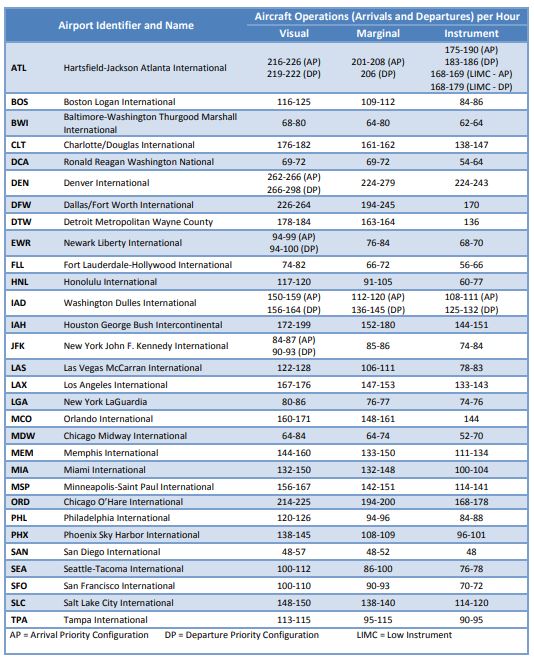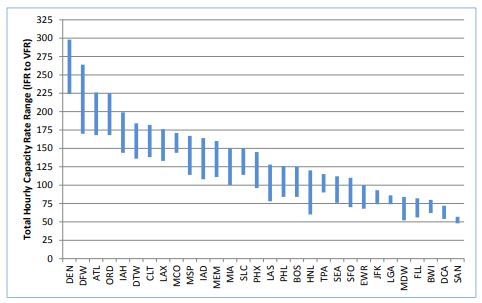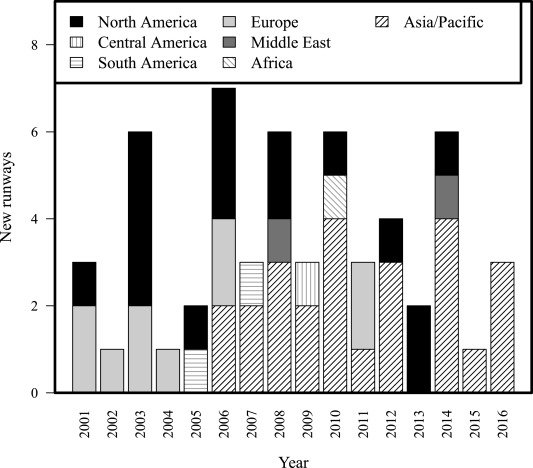Introduction
Managing an airport is technical considering that it comprises a variety of systems, regulations, workers, facilities, and users. Operations are usually intricate and finely-tuned to create a balance between demand and volume, customer experience and the service cost, as well as the anticipated and the unexpected. The success of an airport is defined by its capacity to accommodate cargos and passenger services within its airstrips. Many difficulties encountered during planning are caused by the size and diversity.
In general, the management and planning of airport capacity requires the identification of all activities related to the capability of the airport to handle the demand for flight and passengers. The overall objective is to achieve a sustainable use of infrastructure while considering economic corporate objectives. This paper defines and discusses the planning and management of airport capacity and delay.
Airport Capacity and Delay
Capacity is a term used to refer to the processing capability of the airport within a specific period. Petersen (2018) defines it as operations that can be accommodated by an airport over a given timeframe. Airfield capacity falls under two common categories: practical and throughput capacities. Rodríguez-Sanz et al. (2021) define practical capacity as the amount of take-off and landing operations that an airport can accommodate without surpassing a given number of delays. This category is considered to be the acceptable average delay. On the other hand, throughput capacity involves the rate at which aircraft are comfortably handled in the airfield (Rodríguez-Sanz et al., 2021).
However, it does not consider any delay that may be incurred. In this sense, the definition of throughput capacity is based on the assumption that there will always be aircraft waiting to take off or land (Jacquillat & Odoni, 2018). It, therefore, means that capacity is measured based on the operations that can be achieved within a specific timeframe.
In aviation, there are cases when demand exceeds the capacity of a given facility at the airport or airspace, which results in delays. Sternberg et al. (2017), therefore, define delay as the additional time required to perform airport operations which deviates from the normal. This extra time may be experienced in the form of queuing or waiting for the affected activity, or the reduced speed at which the task is undertaken due to congestion.
In this context, Santos et al. (2017) consider airport operations to include take-off, landing, or the processing of passengers. Delays are likely to occur when at least two aircraft seek to use runways, taxiways, or other airside facilities at the same time. An aircraft has to be subjected to a delay to accommodate another. Other activities prone to delay may occur in the airspace, where aircraft are expected to travel through a specific part of it.
In a case where airplanes seek to operate within evenly spaced time intervals, it will be possible to accommodate all of them depending on the time needed to move each through the facility. On the contrary, Santos et al. (2017) argue that aircraft arrive and leave somewhat randomly, which increases the chances of the occurrence of delay even during times of low demand. Furthermore, the possibility of airplanes using the airport simultaneously increases with traffic density. It means that there is a rise in average delay for every additional airplane as the demand level nears throughput capacity.
Rodríguez-Sanz et al. (2021) further elaborate that when demand exceeds capacity, there will be an excess of aircraft awaiting service and an equal proportion of delay. An airfield with a throughput capacity of 60 operations per hour, for example, may experience demand of 70. This means that for every hour, 10 aircraft will have to queue, which results in delays for subsequent airplanes. This is likely to persist even if demand later drops.
Practically, a flight is said to have been delayed if it departs or arrives fifteen minutes past the scheduled time. For instance, in the year 2015, about 17.5% of the scheduled flights in the United States had delays, and about 21.0% experienced the same in the European market (Santos et al., 2017). Santos et al. (2017) further estimate the figures to be over 2800 daily delayed U.S flights and 6000 flights in Europe.
Therefore, the literature on airline disruption management tends to focus on the management of airport resources such as crew and aircrafts as a way of managing delays. Though the task itself is challenging, the main objective is to minimize operational costs, recovery cost due to disruption and reduce passenger delays (Sternberg et al., 2017). Essentially, flight cancelling, re-timing, swapping, and making requests for the usage of surplus ferrying may serve well to deter aircraft delays. Capacity and delay studies, therefore, serve the main objective of determining effective and efficient ways of increasing airport capacity and reducing delay. This can be achieved by conducting analyses of the implications of proposed facility modifications on service quality.
Factors Affecting Capacity and Delay
Airport capacity is not constant but varies considerably throughout the year or day due to related operational and physical factors. Airspace and airfield geometry, weather, air traffic procedures, and traffic mix are some of the factors causing the capacity variance (Petersen, 2018). A figure allocated to the airfield capacity represents an average which is either based on actual experience of operating or a presumed array of conditions. The variability is more detrimental to the operation as compared to the average value (Petersen, 2018). The strategies for a successful management may include developing ways of compensating for the factors which prompt delay or focus on lowering the capacity.
Airfield Characteristics
The physical characteristics of facilities within an airport not only determine its ability to accommodate various airplane sizes, but also the efficiency of configurations within which the airfield functions. Some of the common physical properties affecting capacity and delay include the extent of counter-rotating vortices, lighting equipment, the number of runways, and the location of airline gates in relation to runway exits (Petersen, 2018).
The layout of taxiways, run-ways, and aprons greatly determine the capability of accommodating various aircrafts and the rates they can handle. The problem of delay prediction is treated in different ways, including delay propagation, cancellation, and root delay (Sternberg et al., 2017). The equipment type installed is also a determinant, though capacity remains constant for a given alignment of taxiways and runways in use.
Airspace Characteristics
The proximity of airports relative to the current has an impact on delays considering that the operations of these airports limit the airspace over which airplanes can be vectored. Relative to the nearby airfields, features, and natural obstacles, the condition of an airport influences the pathways through the flight exclusion zone considered for use to and from the airstrip. Delays are always caused by the need to hold departures in one airport to allow for the clearance of arrivals at another (Sternberg et al., 2017). Alternatively, there may be a need for a gap in the arrival stream to make it easier for one airport to accommodate planes departing from the other.
The geometry of the airspace is constant over time, but whenever the number of airstrips equals or exceeds two in close vicinity, operations in one can considerably interfere with those in the rest. The rate of acceptance of the airstrips may suffer or require an aeroplane to fly circuitous routes in order to prevent conflicts (Petersen, 2018). The interdependence of departure and approach routes can push one airport to hold departures until arrivals at the nearby aircraft clear the airspace.
Air Traffic Control (ATC)
While ATC rules are designed to help with operational safety within airports, some of them limit capacity and affect delays. However, the regulations are necessary for operation to run smoothly, which makes it important to understand their relationship with capacity and delay (Santos et al., 2017). The procedures which govern runway occupancy, use of converging or parallel runways, aircraft separation, and departures as well as arrival spacing can induce delays between subsequent operations. ATC rules impact capacity and delay, especially in cases where there is a simultaneous use of two or more runways, or when arrival streams combine on a final approach pathway (Petersen, 2018).
An example is the procedure on noise-abatement which affects delay, as it is a kind of restriction on airstrips over areas said to be noise sensitive. The availability of equipment for surveillance, navigation, and communication makes it possible for controllers and pilots to maintain the required airport capacity in all weather conditions (Petersen, 2018). However, limits such as clearance applied in the terminal airspace tend to be circuitous, which increases the possibility of routing aircraft through intermediate fixes instead of allowing for direct travel, hence delays.
Meteorological Conditions
The operations of an airport are dependent on considerations of wind directions, visibility, ceiling, and precipitation. Such weather patterns not only determine the runway configuration but also the control procedures used to process aircraft entering and leaving the field (Rodríguez-Sanz et al., 2021). The Federal Aviation Administration (2014) used the rates in Table 1 (see Table 1) to plot a graph of possible capacity range for various airports under different visual rates and weather conditions (see Table 2). During clear weather, airport capacity is the highest because visibility is at its finest.

However, weather extremes such as strong winds, fog, precipitation, and snow accumulation on the runway reduce its capacity (Rodríguez-Sanz et al., 2021). A common incident such as wind shift disrupts operations, but traffic is redirected to another pattern. In case the new pattern is not optimal, capacity decreases as much as the wind prevails. Indeed, the combined influence of runway configuration, weather, and ATC rules causes severe capacity loss and delays in many airports.

Estimating Capacity and Delay
Estimations of airport capacity are important for addressing airport management, planning, and design issues. Capacity assessment, therefore, influences the focus and details of services offered at the airport. However, Petersen (2018) states that generally accepted service-level targets have to exist to facilitate the assessment of airport capacity. In this regard, the process must consider both the existing service and the volume accommodated by them.
It also means that there have to be records of passenger demands and airport operating procedures. Dray (2020), for example, obtained expansion data to identify the capacities for various airports in different regions in terms of movements per hour (see Table 3). In the period of data collection, airports were found to either add runways or replace existing ones to increase the capacity. Table 3 provides the distribution of the additional runways by region.

The measurement of delay, on the other hand, should be done against standard flight times. However, Sternberg et al. (2017) argue that there is always a likelihood of overestimation of delay because different airports have variations in their “no-delay” time. Additionally, operations which may be counted as delays in one airport may range within the normal expectancy depending on the circumstances at another airport (Santos et al., 2017).
In this regard, airline schedules tend to have a built-in allowance to cater for potential delays. In part, Sternberg et al. (2017) consider this to be realistic planning, but some airports inflate published flight times to enhance their reputation in terms of on-time operation. The systems for measuring delay tend to incorporate all forms of delay experienced en route and are less likely to be linked to conditions at the airport. This means that including them in overall airport estimates can only mean overestimation.
Conclusion
Airport delay is epitomised by the difference between scheduled arrival and departure times and caused by lack of capacity. Apart from increasing operational costs, flight delays hurt airlines, passengers, and management as well. It is important to predict the occurrence in the decision-making process and consider the factors that induce the delay. In any case, airports are a part of a country’s system and economy and must, therefore, operate successfully. Certainly, a focus on airport capacity can help address and enhance the issue of economic recovery of airports. Failure to accommodate the increasing levels of operations will result in the transportation system suffering. However, even though problems associated with capacity and delays are foreseeable and manageable, they cannot be eliminated.
References
Dray, L. (2020). An empirical analysis of airport capacity expansion. Journal of Air Transport Management, 87, 101850.
Federal Aviation Administration. (2014). Airport capacity profiles. Web.
Jacquillat, A., & Odoni, A. R. (2018). A roadmap toward airport demand and capacity management. Transportation Research Part A: Policy and Practice, 114, 168-185.
Petersen, R. (2018). Capacity constraints for air traffic flow development.
Rodríguez-Sanz, Á., Cano, J., & Fernández, B. R. (2021). Impact of weather conditions on airport arrival delay and throughput. In IOP Conference Series: Materials Science and Engineering (vol. 1024, no. 1, p. 012107). IOP Publishing.
Santos, B. F., Wormer, M. M., Achola, T. A., & Curran, R. (2017). Airline delay management problem with airport capacity constraints and priority decisions. Journal of Air Transport Management, 63, 34-44. Web.
Sternberg, A., Soares, J., Carvalho, D., & Ogasawara, E. (2017). A review on flight delay prediction. Constraints, 1-21.